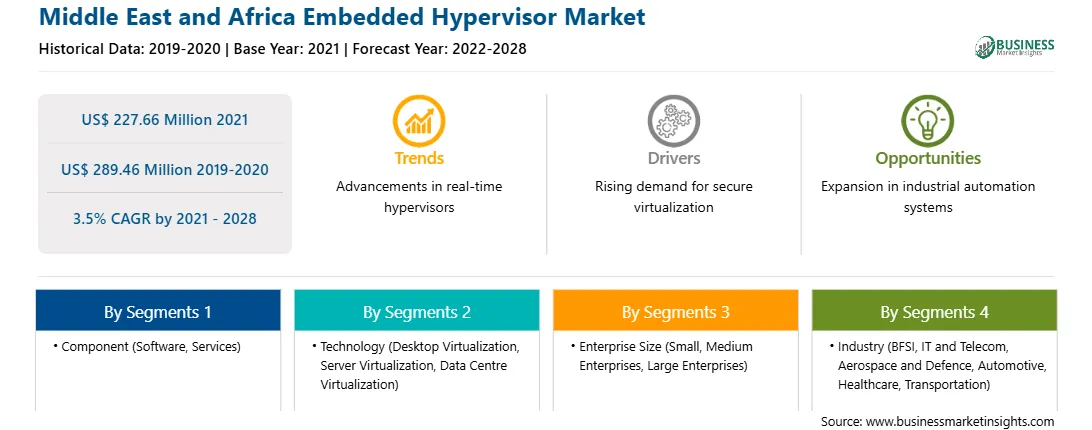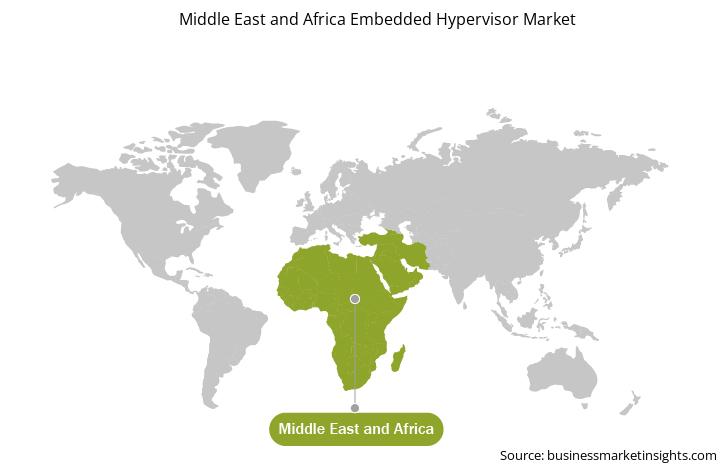Middle East and Africa Embedded Hypervisor Market
No. of Pages: 105 | Report Code: BMIRE00025203 | Category: Technology, Media and Telecommunications
No. of Pages: 105 | Report Code: BMIRE00025203 | Category: Technology, Media and Telecommunications
The advent of IoT enables each device to be connected over the internet, and its rising adoption in the MEA results in more than billions of devices connected over the internet. Furthermore, the data traffic rate grew at an annual rate of more than ~65% over the last five years. Also, between 2018 and 2023, the data traffic is anticipated to grow at a compound annual growth rate of ~40%. This exponential growth in data traffic over the internet is primarily attributed to the growing penetration of smartphones and other consumer electronic devices connected over the internet due to the increasing popularity of IoT and cloud computing technology.
Cloud computing is used in vertical applications, such as Infrastructure-as-a-Service (IaaS), Platform-as-a-Service (PaaS), Software-as-a-Service (SaaS), big data analytics, education, cloud storage, data backup, entertainment, management, and social networking. Companies plan to increase their 2022 spending on machine learning and AI platforms from 1% to 25%. Hence, increasing spending for adopting advanced technologies and the growing popularity of cloud computing technology is paving new opportunities for deploying embedded hypervisors in the ecosystem, which is driving the market growth.
Strategic insights for the Middle East and Africa Embedded Hypervisor provides data-driven analysis of the industry landscape, including current trends, key players, and regional nuances. These insights offer actionable recommendations, enabling readers to differentiate themselves from competitors by identifying untapped segments or developing unique value propositions. Leveraging data analytics, these insights help industry players anticipate the market shifts, whether investors, manufacturers, or other stakeholders. A future-oriented perspective is essential, helping stakeholders anticipate market shifts and position themselves for long-term success in this dynamic region. Ultimately, effective strategic insights empower readers to make informed decisions that drive profitability and achieve their business objectives within the market.

| Report Attribute | Details |
|---|---|
| Market size in 2021 | US$ 227.66 Million |
| Market Size by 2028 | US$ 289.46 Million |
| Global CAGR (2021 - 2028) | 3.5% |
| Historical Data | 2019-2020 |
| Forecast period | 2022-2028 |
| Segments Covered |
By Component
|
| Regions and Countries Covered | Middle East and Africa
|
| Market leaders and key company profiles |
The geographic scope of the Middle East and Africa Embedded Hypervisor refers to the specific areas in which a business operates and competes. Understanding local distinctions, such as diverse consumer preferences (e.g., demand for specific plug types or battery backup durations), varying economic conditions, and regulatory environments, is crucial for tailoring strategies to specific markets. Businesses can expand their reach by identifying underserved areas or adapting their offerings to meet local demands. A clear market focus allows for more effective resource allocation, targeted marketing campaigns, and better positioning against local competitors, ultimately driving growth in those targeted areas.

MEA Embedded Hypervisor Market Segmentation
The MEA embedded hypervisor market is segmented based on component, technology, enterprise size, industry, and country. Based on component, the MEA embedded hypervisor market is segmented into solution and services. The solution segment dominated the MEA embedded hypervisor market in 2020. Based on technology, the MEA embedded hypervisor market is segmented into desktop virtualization, server virtualization, and data center virtualization. The desktop virtualization segment dominated the MEA embedded hypervisor market in 2020. Based on enterprise size, the MEA embedded hypervisor market is segmented into small and medium enterprises and large enterprises. The large enterprises segment dominated the MEA embedded hypervisor market in 2020. Based on industry, the MEA embedded hypervisor market is segmented into BFSI, IT and telecom, aerospace and defense, automotive, healthcare, transportation, and others. The BFSI segment dominated the MEA embedded hypervisor market in 2020. Based on country, the MEA embedded hypervisor market is segmented into Saudi Arabia, the UAE, South Africa, and the Rest of the MEA. The Saudi Arabia segment dominated the MEA embedded hypervisor market in 2020.
Citrix System, Inc.; IBM Corporation; Microsoft Corporation; VMware, Inc.; Wind River System, Inc.; NXP Semiconductors; Thales Group; and
Siemens AG
are among the leading companies in the MEA embedded hypervisor market.
The Middle East and Africa Embedded Hypervisor Market is valued at US$ 227.66 Million in 2021, it is projected to reach US$ 289.46 Million by 2028.
As per our report Middle East and Africa Embedded Hypervisor Market, the market size is valued at US$ 227.66 Million in 2021, projecting it to reach US$ 289.46 Million by 2028. This translates to a CAGR of approximately 3.5% during the forecast period.
The Middle East and Africa Embedded Hypervisor Market report typically cover these key segments-
The historic period, base year, and forecast period can vary slightly depending on the specific market research report. However, for the Middle East and Africa Embedded Hypervisor Market report:
The Middle East and Africa Embedded Hypervisor Market is populated by several key players, each contributing to its growth and innovation. Some of the major players include:
The Middle East and Africa Embedded Hypervisor Market report is valuable for diverse stakeholders, including:
Essentially, anyone involved in or considering involvement in the Middle East and Africa Embedded Hypervisor Market value chain can benefit from the information contained in a comprehensive market report.